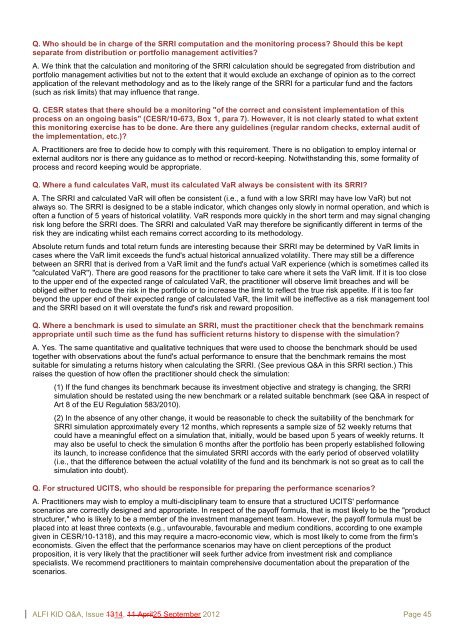ALFI UCITS IV implementation project – KID Q&A Document
ALFI UCITS IV implementation project – KID Q&A Document
ALFI UCITS IV implementation project – KID Q&A Document
You also want an ePaper? Increase the reach of your titles
YUMPU automatically turns print PDFs into web optimized ePapers that Google loves.
Q. Who should be in charge of the SRRI computation and the monitoring process? Should this be keptseparate from distribution or portfolio management activities?A. We think that the calculation and monitoring of the SRRI calculation should be segregated from distribution andportfolio management activities but not to the extent that it would exclude an exchange of opinion as to the correctapplication of the relevant methodology and as to the likely range of the SRRI for a particular fund and the factors(such as risk limits) that may influence that range.Q. CESR states that there should be a monitoring "of the correct and consistent <strong>implementation</strong> of thisprocess on an ongoing basis" (CESR/10-673, Box 1, para 7). However, it is not clearly stated to what extentthis monitoring exercise has to be done. Are there any guidelines (regular random checks, external audit ofthe <strong>implementation</strong>, etc.)?A. Practitioners are free to decide how to comply with this requirement. There is no obligation to employ internal orexternal auditors nor is there any guidance as to method or record-keeping. Notwithstanding this, some formality ofprocess and record keeping would be appropriate.Q. Where a fund calculates VaR, must its calculated VaR always be consistent with its SRRI?A. The SRRI and calculated VaR will often be consistent (i.e., a fund with a low SRRI may have low VaR) but notalways so. The SRRI is designed to be a stable indicator, which changes only slowly in normal operation, and which isoften a function of 5 years of historical volatility. VaR responds more quickly in the short term and may signal changingrisk long before the SRRI does. The SRRI and calculated VaR may therefore be significantly different in terms of therisk they are indicating whilst each remains correct according to its methodology.Absolute return funds and total return funds are interesting because their SRRI may be determined by VaR limits incases where the VaR limit exceeds the fund's actual historical annualized volatility. There may still be a differencebetween an SRRI that is derived from a VaR limit and the fund's actual VaR experience (which is sometimes called its"calculated VaR"). There are good reasons for the practitioner to take care where it sets the VaR limit. If it is too closeto the upper end of the expected range of calculated VaR, the practitioner will observe limit breaches and will beobliged either to reduce the risk in the portfolio or to increase the limit to reflect the true risk appetite. If it is too farbeyond the upper end of their expected range of calculated VaR, the limit will be ineffective as a risk management tooland the SRRI based on it will overstate the fund's risk and reward proposition.Q. Where a benchmark is used to simulate an SRRI, must the practitioner check that the benchmark remainsappropriate until such time as the fund has sufficient returns history to dispense with the simulation?A. Yes. The same quantitative and qualitative techniques that were used to choose the benchmark should be usedtogether with observations about the fund's actual performance to ensure that the benchmark remains the mostsuitable for simulating a returns history when calculating the SRRI. (See previous Q&A in this SRRI section.) Thisraises the question of how often the practitioner should check the simulation:(1) If the fund changes its benchmark because its investment objective and strategy is changing, the SRRIsimulation should be restated using the new benchmark or a related suitable benchmark (see Q&A in respect ofArt 8 of the EU Regulation 583/2010).(2) In the absence of any other change, it would be reasonable to check the suitability of the benchmark forSRRI simulation approximately every 12 months, which represents a sample size of 52 weekly returns thatcould have a meaningful effect on a simulation that, initially, would be based upon 5 years of weekly returns. Itmay also be useful to check the simulation 6 months after the portfolio has been properly established followingits launch, to increase confidence that the simulated SRRI accords with the early period of observed volatility(i.e., that the difference between the actual volatility of the fund and its benchmark is not so great as to call thesimulation into doubt).Q. For structured <strong>UCITS</strong>, who should be responsible for preparing the performance scenarios?A. Practitioners may wish to employ a multi-disciplinary team to ensure that a structured <strong>UCITS</strong>' performancescenarios are correctly designed and appropriate. In respect of the payoff formula, that is most likely to be the "productstructurer," who is likely to be a member of the investment management team. However, the payoff formula must beplaced into at least three contexts (e.g., unfavourable, favourable and medium conditions, according to one examplegiven in CESR/10-1318), and this may require a macro-economic view, which is most likely to come from the firm'seconomists. Given the effect that the performance scenarios may have on client perceptions of the productproposition, it is very likely that the practitioner will seek further advice from investment risk and compliancespecialists. We recommend practitioners to maintain comprehensive documentation about the preparation of thescenarios.<strong>ALFI</strong> <strong>KID</strong> Q&A, Issue 1314, 11 April25 September 2012 Page 45
















